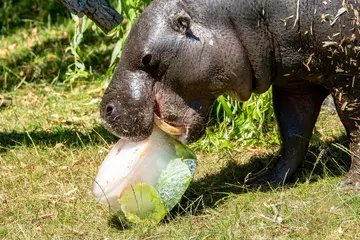
Pygmy hippo facts
There are two species of hippo: common hippos and pygmy hippos.
Fun fact: The word Hippopotamus comes from the Ancient Greek - 'hippo' meaning horse and 'potamo' meaning river.
Hippos have very sensitive skin which easily becomes dry and cracked. They produce a pigment that acts as a natural sunscreen - a fluid oozes from glands under the skin which helps keep it moist and protected from the sun's rays.
Are there hippos at Whipsnade Zoo?
At Whipsnade Zoo, we’re home to a pygmy hippo, Tapon. Our common hippos moved to Longleat Safari Park in June 2025. Look out for Tapon munching grass or his favourite vegetables in his paddock, swimming in his own private pool, or snoozing in the sunshine.

What do pygmy hippos look like and what adaptations do they have?
These shy, nocturnal, and often solitary mammals are more land-based (terrestrial) than their larger, river-dwelling common hippo relatives.
They are adapted to living in a forest environment, with a smaller body and head for weaving through the vegetation, and longer legs.
Their eyes are on the sides of their head instead of on the top, enabling them to see better whilst running through forests. Their feet are also less webbed, as they spend more time walking on land than in the water.

What do pygmy hippos eat?
Pygmy hippos are herbivores, feeding on a variety of vegetation, including leaves, semi-aquatic plants, and fallen fruit.
Fun fact: Hippos are noisy feeders! A pygmy hippo can sometimes be heard eating from up to 50m away.
Where do pygmy hippos live?
In the wild, pygmy hippos are found in West Africa and tend to live solitary lives in lowland tropical forests close to rivers, streams and swamps.
What threats do pygmy hippos face in the wild?
Pygmy hippos are Endangered in the wild, with the main threat being habitat loss. Their forest homes are being destroyed due to logging, farming, and human settlement.
With only an estimated 2,500 pygmy hippos left in the wild, ZSL – the science-driven conservation charity behind Whipsnade Zoo – has worked to protect the species through its work with local communities and wildlife authorities in Liberia and Sierra Leone, as well as through vital conservation breeding programmes.
Pygmy hippos are living on the EDGE
Pygmy hippos are recognised on ZSL's EDGE list of unique and threatened animals, which helps us focus our conservation efforts where they are most needed.
